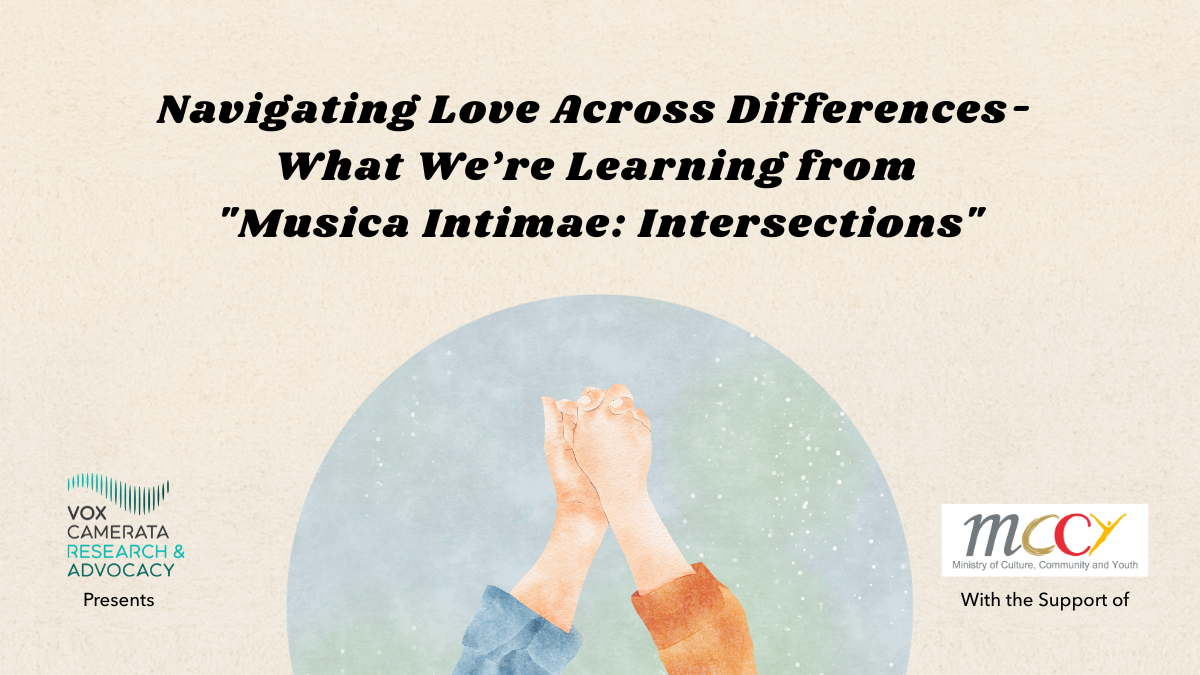Navigating Love Across Differences- What We’re Learning from "Musica Intimae: Intersections"
Since starting our ethnographic work in preparation for our Musica Intimae: Intersections Festival, we've made a few fascinating discoveries from both our interviews and our literature reviews.

Since starting our ethnographic work in preparation for our Musica Intimae: Intersections Festival, we've made a few fascinating discoveries from both our interviews and our literature reviews. The first phase of Musica Intimae: Intersections aims to excavate the lived experience of bi-racial and bi-religious couples in Singapore, so many of the insights gleaned have come directly from Singaporean couples who took the time to share their journey with our researchers.
In this post, we will briefly share some of the challenges many bi-racial and bi-religious couples face in building a life together.
1. Communication Barriers
Cultural backgrounds shape communication styles, and individuals raised in a different culture often grow used to communicating, or being communicated to, in one style or another. One partner may speak directly; the other may prefer indirect approaches. Some individuals or coupes oscillate between communication styles, depending on circumstances, the issue at hand, or the people involved.
These differences cause misunderstandings and may lead to resentment. In Singapore, most couples are fortunate enough to share English as a common language, reducing the added obstacle of language barriers. Still, differences in communication styles, compounded further by divergences in cultural practices, values, and religious observances, often lead to friction, especially when it involves sensitive issues such as family traditions or child-rearing.
2. Societal Pressures and Discrimination
Inter-racial couples often face public scrutiny due to heightened visibility, and one consequence of this is an increased exposure to discrimination. Societal norms and criticism from cultural communities may also create additional pressure.
Hostile online or offline comments, negative portrayals, and family disapproval are common and often suffered silently.The majority partner may not understand the minority partner’s systemic challenges. The minority partner may experience more frequent discrimination, especially as the couple maneuver into majority-dominated spaces with their partner.
This can cause feelings of social isolation and emotional strain. Couples must often explain their experiences to each other, which can lead to frustration and misunderstanding.
3. Identity and Cultural Appropriation
Partners may struggle with cultural and religious identity, for both themselves and their children. Cultural appropriation is a risk; respect and sensitivity are essential. Stereotypes and negative perceptions of other ethnic groups still persist, which may sometimes get in the way of understanding and appreciation.
This may be compounded by expectations from family, friends, and the community, as they may desire to see certain cultural or religious traditions being practiced and observed, even when one partner may not understand the importance of doing so, or do not view it as relevant to their lives.
4. Family Expectations and Social Isolation
Family acceptance is a major hurdle. Families may question, if not pressure couples about religious affiliations and partner choices. This can cause conflict if one partner does not share the family’s beliefs. Disapproval can lead to emotional pressure, secrecy, or even relationship breakdown. Some families promote “racial purity” or religious homogeneity, pressuring children to choose partners within their own communities.
When such expectations are not met or subverted, families have been known to reduce or even cut off contact with the couple. This results in social isolation, to varying degrees. In some families for example, one parent or a few members may choose to break contact with someone who marries from another ethnicity or religion, but other family members will maintain contact. In more extreme cases, an entire family may choose to break off contact with the couple.
Monocultural couples in Singapore report higher marital satisfaction, partly due to fewer family-related problems. Family units in Singapore often prioritize tradition, which can intensify resistance to inter-ethnic or inter-religious unions. Some couples hide their relationships or end them due to persistent family opposition.
5. Differences in Beliefs
Inter-religious couples often disagree on core beliefs and values. These disagreements can occur even when couples practice the same religion but when one partner practices a different religion altogether, the tensions are often heightened, epecially when they affect major aspects of life, such as child-rearing, funerary practices, or marriage rituals.
While some couples or individuals may not be as religious as others, they still encounter situations where the topic of religion is raised, such as when encountering beareucratic forms asking them to state their religion or that of their partner's and children, or when their young children or others in their social circle ask about their religion, or when they are asked about their dietary requirements.
6. Divergent Practices
Partners may differ in their commitment to religious rituals and practices. One may be more involved in worship or lifestyle choices, or have particular views on spirituality and religious rituals. This imbalance can create tension, especially when expectations are not communicated clearly.
Couples who are able to identify shared practices and engage in mutual spiritual experiences tend to minimise such friction. Even when choosing to practice different religions, respect for each other’s practices strengthens bonds.
7. Community Pressures
Religious communities may expect couples to follow specific rituals, contribute financially, attend certain events, or commit in other ways. These demands can cause stress, especially if one partner feels less committed, or is perceived as being coerced.
Setting clear boundaries with communities helps couples prioritize their relationship.
8. Compromise in Religious Upbringing
Deciding a child’s religious upbringing is often contentious. Beyond simply picking a religion for their children, couples often engage in long deliberations so that they can agree on the importance of religion in the first place, and its roles in their children’s education.
Consensus reduces confusion and strengthens family unity. Incorporating both religions into family practices can respect both partners’ beliefs.
Opportunities for Growth
Despite challenges, the number of bi-ethnic and bi-religious couples are steadily rising and will likely continue to do so in Singapore. These relationships offer opportunities for growth and enrichment. Couples develop mutual understanding, celebrate diversity, and create unique family identities.
Societal attitudes are gradually shifting, though challenges persist. In the next part of our Musica Intimae: Intersections series, we will explore what strategies, tools, and resources couples use to navigate and overcome the challenges listed above.
Conclusion
Bi-racial and bi-religious couples in Singapore face communication barriers, societal and family pressures, identity struggles, and challenges in religious practice. The Musica Intimae project continues to document these experiences, highlighting both the difficulties and the resilience of these couples
Musica Intimae: Intersections is supported by the Ministry of Culture, Community and Youth, Singapore, through the Harmony Fund.

